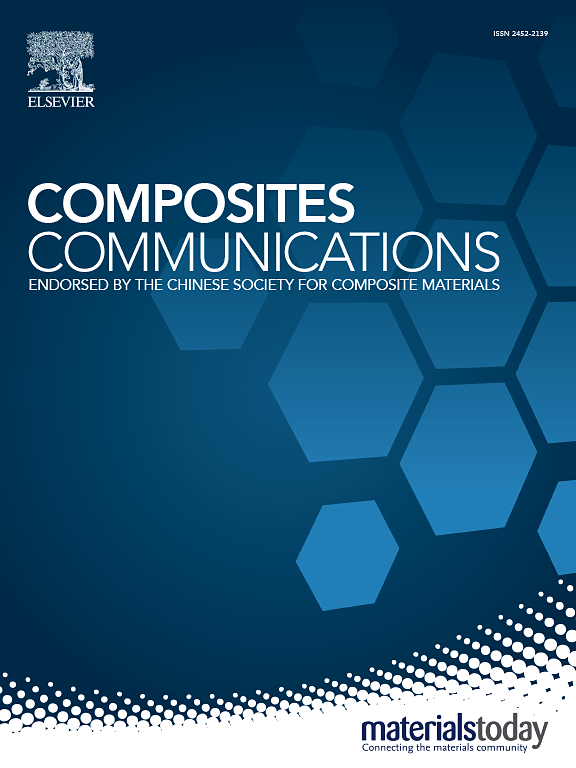Modulation of interface and intermetallics by minor nano-Ti addition for enhancing mechanical properties and wear resistance in the short carbon fiber/Cu composites
IF 7.7
2区 材料科学
Q1 MATERIALS SCIENCE, COMPOSITES
引用次数: 0
Abstract
Short carbon fiber/Cu composites with the minor nano-Ti addition were fabricated using a hot-pressed sintering process from a powder mixture of short carbon fiber, nano-Ti, and Cu. The effects of nano-Ti content on the microstructure and mechanical properties of short carbon fiber/Cu composites were characterized. For microstructural observation, a TiC interfacial nano-layer was formed between Cu matrix and short carbon fibers, and CuTi compounds were identified in the compacts during the sintering. The results of mechanical properties test shown that the sintered compacts exhibited the higher hardness and room-temperature tensile strength as the amount of nano-Ti increased. With 3.5 wt% nano-Ti addition, the short carbon fiber/Cu composite exhibited a 120 % increase in hardness and a 96 % increase in ultimate tensile strength compared to the 0 wt% nano-Ti sample, while retaining 15.5 % elongation. Based on the ball-on-disk dry friction wear test, the addition of nano-Ti effectively enhanced the wear resistance of short carbon fiber/Cu composites, exhibited the lower friction coefficient (0.28) and wear rate (9.6 × 10−5 mm3/N·m). The relevant structural formation, strengthening, and wear mechanisms of the nano-Ti added short carbon fiber/Cu composites are discussed.
微量纳米ti对短碳纤维/Cu复合材料界面和金属间化合物的调制提高其力学性能和耐磨性
以短碳纤维、纳米ti和Cu为原料,采用热压烧结法制备了纳米ti加入短碳纤维/Cu复合材料。研究了纳米ti含量对短碳纤维/Cu复合材料显微组织和力学性能的影响。显微结构观察发现,在Cu基体与短碳纤维之间形成了TiC界面纳米层,烧结过程中在压坯中发现了CuTi化合物。力学性能测试结果表明,随着纳米ti含量的增加,烧结坯的硬度和室温抗拉强度均有所提高。当纳米钛含量为3.5 wt%时,与纳米钛含量为0 wt%的样品相比,短碳纤维/Cu复合材料的硬度提高了120%,极限拉伸强度提高了96%,同时伸长率保持在15.5%。基于球盘式干摩擦磨损试验,纳米ti的加入有效提高了短碳纤维/Cu复合材料的耐磨性,摩擦系数(0.28)和磨损率(9.6 × 10−5 mm3/N·m)均有所降低。讨论了纳米ti加入短碳纤维/Cu复合材料的结构形成、强化和磨损机理。
本文章由计算机程序翻译,如有差异,请以英文原文为准。
求助全文
约1分钟内获得全文
求助全文
来源期刊

Composites Communications
Materials Science-Ceramics and Composites
CiteScore
12.10
自引率
10.00%
发文量
340
审稿时长
36 days
期刊介绍:
Composites Communications (Compos. Commun.) is a peer-reviewed journal publishing short communications and letters on the latest advances in composites science and technology. With a rapid review and publication process, its goal is to disseminate new knowledge promptly within the composites community. The journal welcomes manuscripts presenting creative concepts and new findings in design, state-of-the-art approaches in processing, synthesis, characterization, and mechanics modeling. In addition to traditional fiber-/particulate-reinforced engineering composites, it encourages submissions on composites with exceptional physical, mechanical, and fracture properties, as well as those with unique functions and significant application potential. This includes biomimetic and bio-inspired composites for biomedical applications, functional nano-composites for thermal management and energy applications, and composites designed for extreme service environments.
 求助内容:
求助内容: 应助结果提醒方式:
应助结果提醒方式:


